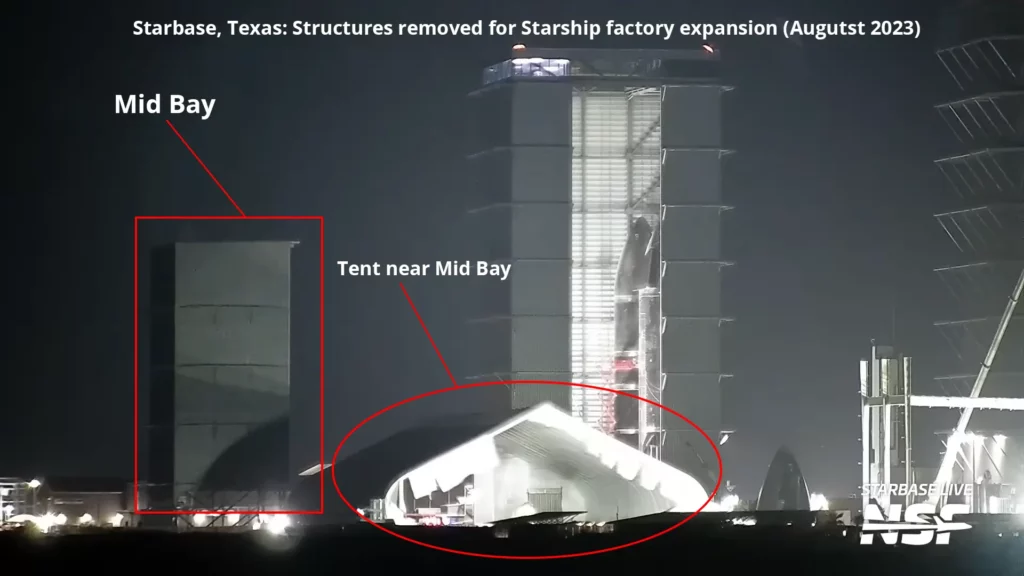Starbase, Texas: SpaceX has been intensely busy in preparation for the next Starship orbital flight since the 1st static fire test of Super Heavy Booster 9 earlier this month.
SpaceX performed a 2nd full-scale 33-engine static fire test on Booster 9 on Friday 25th August. This was a major development at Starbase last week.
SpaceX is also reshaping the Starship production site at Starbase to create the needed space for the Starship factory (Starfactory) expansion. SpaceX started the expansion of the Starfactory last month. Further expansion is underway (details and video below).

2nd Static Fire Test of Super Heavy Booster 9
SpaceX conducted the 2nd static fire test of Booster 9 with a full spectrum of 33 Raptor engines installed. The 1st static fire test earlier this month was not a 100% success as only 29 out of 33 engines had fired successfully. Because 4 engines had either failed or were shut down intentionally, a 2nd test needed to be performed for accurate data and analysis.
The 2nd static fire test of Booster 9 was set for a full duration of 6 seconds. According to SpaceX, the test ran for entire 6 seconds and all 33 Raptor engines fired successfully but only 31 of them fired for the full 6-second duration. However, Elon Musk declared this a successful test.
Booster 9 was filled with liquid oxygen (LOX) to a maximum but methane was partially loaded. SpaceX loaded enough methane that would last for the entire 6-second duration of the test.
A static fire test at SpaceX is also called a ‘flight-like startup’ test as well. This is because the engines of a Booster or Starship are ignited the same as they would in a real flight, but comparatively the duration of the engine firing is short.
Another important detail to note is that in a static fire test, the engines are throttled to a maximum of 50% of thrust. A 2nd-generation Raptor engine at full thrust produces 230 tons or 500,000 lb of downforce.
During the live stream of the test (watch the recording below), a SpaceX engineer explained the progress that the company has made from the 1st to 2nd static fire and how valuable these tests are for an actual flight, he said:
So, with static fire, we’re looking to do what’s called a flight-like startup. So, this is us putting the hardware in essentially a flight-like environment as close to what it’s going to see on an actual launch day.
And this really gives you an opportunity to see how all the hardware behaves when it’s all interacting together where we tweaked some of the startup sequence from the last time we did a static fire.
As we just continue to fine-tune, learn about the hardware as we put it through the paces, and fine-tune our operations just as we get ready to get onto flight number 2.
SpaceX CEO Elon Musk shared the following stunning aerial image of the Booster 9 static fire test as the engines were on full thrust. “Getting ready for next Starship flight,” he said.

An extended version of the Booster 9 static fire video (below) shows that the new Orbital Launch Mount (OLM) deluge system keeps releasing water for several seconds even after the engines complete the firing. So far, the new OLM water deluge system has been a success and performed well in protecting the OLM in both static fire tests. The previous version of the OLM deluge system partially failed to protect the OLM from damage.
Starfactory Construction Update: Mid Bay Demolition, Tent Removed
To speed up and scale Starship production, SpaceX is expanding the Starfactory at Starbase, Texas. In the process of creating room for the factory, the space exploration company is removing large structures that come in the way of the expansion.
During last week SpaceX removed 2 large structures from the Starbase launch site. First, the tent near Mid Bay was removed and in the next step, the Mid Bay was also demolished as well (video below).

The tent I have marked in the above screenshot from the NASASpaceFlight Starbase coverage video is not as small as it looks in the picture. A Starbase video tour by Elon Musk with Tim Dodd (Everyday Astronaut) showed one of these tents and SpaceX had stored dozens of Raptor 2 engines inside. These tents are basically used for the production and storage of Starship components.
A large box was also transported to the Starlink building. Most probably this box either contains a Starlink V2 satellite or its components. SpaceX plans to use Starship for the deployment of larger Starlink V2 satellites.
Starlink V2 satellites were first spotted at Starbase in November last year when Gwynne Shotwell took charge of this SpaceX Starship development and launch facility. A couple of more large container-sized boxes also arrived at Starbase but it’s not clear what’s inside them, probably tooling parts for the Starfactory.
Related
- Elon Musk shares Starship Flight 5 Super Heavy rocket inspection results after the landing catch
- SpaceX successfully catches Flight 5 Starship Super Heavy rocket booster on landing (videos)
- The FAA grants Starship Flight 5 license, SpaceX readies for launch on Sunday morning
- Starship Flight 5 can happen as early as 13th October, pending regulatory approval, SpaceX
- FAA proposes $600K+ fines on SpaceX for flight violations, Elon Musk threatens to sue the FAA, Starship updates
- Starship update: Delays in regulatory approvals threaten America’s lead in space, Flight 5 license expected in November, SpaceX







